Researchers at the Medical School have found that using focused ultrasound technology — a non-invasive type of brain surgery — can reduce tremor symptoms in some Parkinson’s disease patients while also improving quality of life.
Parkinson’s disease is a progressive neurological disorder that affects movement by impacting the dopamine-producing neurons in a part of the brain known as the substantia nigra. Dopamine is a neurotransmitter — a chemical substance transmitted from one neuron to another — that is known to be involved in movement.
The specific symptoms of this disorder vary from patient to patient. While some experience behavioral symptoms such as tremors, slowed movement, muscle rigidity and impaired balance, others also see changes in mood and cognition, especially in later stages of the disease when other brain pathways may be affected.
Due to the heterogeneity of the disease, there is no single treatment, and its causes remain unknown. The fact that Parkinson’s disease affects the brain poses another challenge for researchers and clinicians regarding treatment.
“Unlike things like kidney disease and liver disease, we can’t really take the brain out and put a new one back in,” said Binit Shah, a neurologist at the University Medical Center. “So, I think the amount that we can improve and learn is exponential.”
However, a number of treatments do exist and have been effective for a subset of Parkinson’s disease patients’ symptoms. According to Shah, one of the most conservative treatments — and one of the most important — is physical exercise and activity.
With patients who have tremor symptoms related to the loss of dopamine-releasing neurons, the medication Levodopa is used as a treatment, as it can be converted to dopamine and help with movement control. Although the medication can continue to remain effective for later stages of the disease, the disease progression may also develop other symptoms that the medication does not target.
“It may take more medication to get the same effect because the cells that make dopamine may not be functioning well or are degenerating, but also other features of PD can develop like problems with balance, swallowing, cognition, where the problem is not the lack of dopamine but is due to PD spreading to other parts of the brain,” Shah said.
In cases where medication is not effective, deep brain stimulation, or DBS, has been used. DBS is an invasive procedure in which electrodes are implanted within certain areas of the brain and produce electrical impulses to disrupt irregular signaling. However, not all Parkinson’s patients are candidates for DBS, and some of those who are choose to opt out due to its invasiveness.
Currently, a team of researchers and clinicians led by University neurosurgeon Jeff Elias — and including Shah and clinical neuropsychologist Scott Sperling — have pioneered the use of a new technology known as focused ultrasound to reduce tremor symptoms in Parkinson’s patients.
In focused ultrasound, beams of ultrasound waves concentrate on a target with extreme precision and accuracy. This technology has been used to target tumors as well as open up the blood brain barrier — which prevents many treatments from entering the brain — so that medications can effectively enter and target areas in the brain.
In the study, Parkinson’s disease patients were divided into two groups — one group received the focused ultrasound treatment, while the other did not receive this treatment. The focused ultrasound technology targeted the ventralis intermedius nucleus of the thalamus.
“The thalamus is segmented into different areas, and one of those areas is a coordination [center] where a lot of motor fibers intercept and there are tremor fibers that can go through,” Shah said.
While Elias administered the treatment, Shah did motor assessments in collaboration with other institutions without knowledge of the treatment the patient had received. The research found that there was significant reduction in tremor symptoms for the Parkinson’s disease patients who received focused ultrasound treatment. There was not a significant reduction in other symptoms, such as depression.
At the same time, the researchers found that this focused ultrasound technology is safe and improves the quality of life for Parkinson’s patients. Sperling measured the quality of life of these patients who underwent the procedure over the span of a year.
“What you do see is that individuals who had treatment had significant improvements in their quality of life, and if you track all the folks over the next years, you continue to see significant improvements in overall quality of life and in areas such as emotional wellbeing,” Sperling said.
Now, the researchers and clinicians are looking into using focused ultrasound technology in other areas of the brain such as the subthalamic nucleus of the thalamus and the globus pallidus — both areas that research has shown to be potential targets for Parkinson’s disease. They hope to see if there are significant reductions in other motor symptoms as well as improvements in quality of life.
Nevertheless, the complexity of the disease may continue to require that research produce new treatments for Parkinson’s disease.
“These surgeries are new and not for everyone. It's important to note that with Parkinson’s disease there are a lot of effective treatments from [a] medication standpoint and DBS, which remains the primary neurosurgical treatment,” Sperling said. “But this is something that is new and could be [an option] for certain individuals but are not standard practice for everyone with Parkinson’s disease.”







